VERY RARE! WWII 1944 Type 1 Invasion of Normandy "1st Royal Tank Regiment - Liberation of Lisieux" British Ministry of Information Photograph Department Press Photograph (OVERSIZED PRINT)

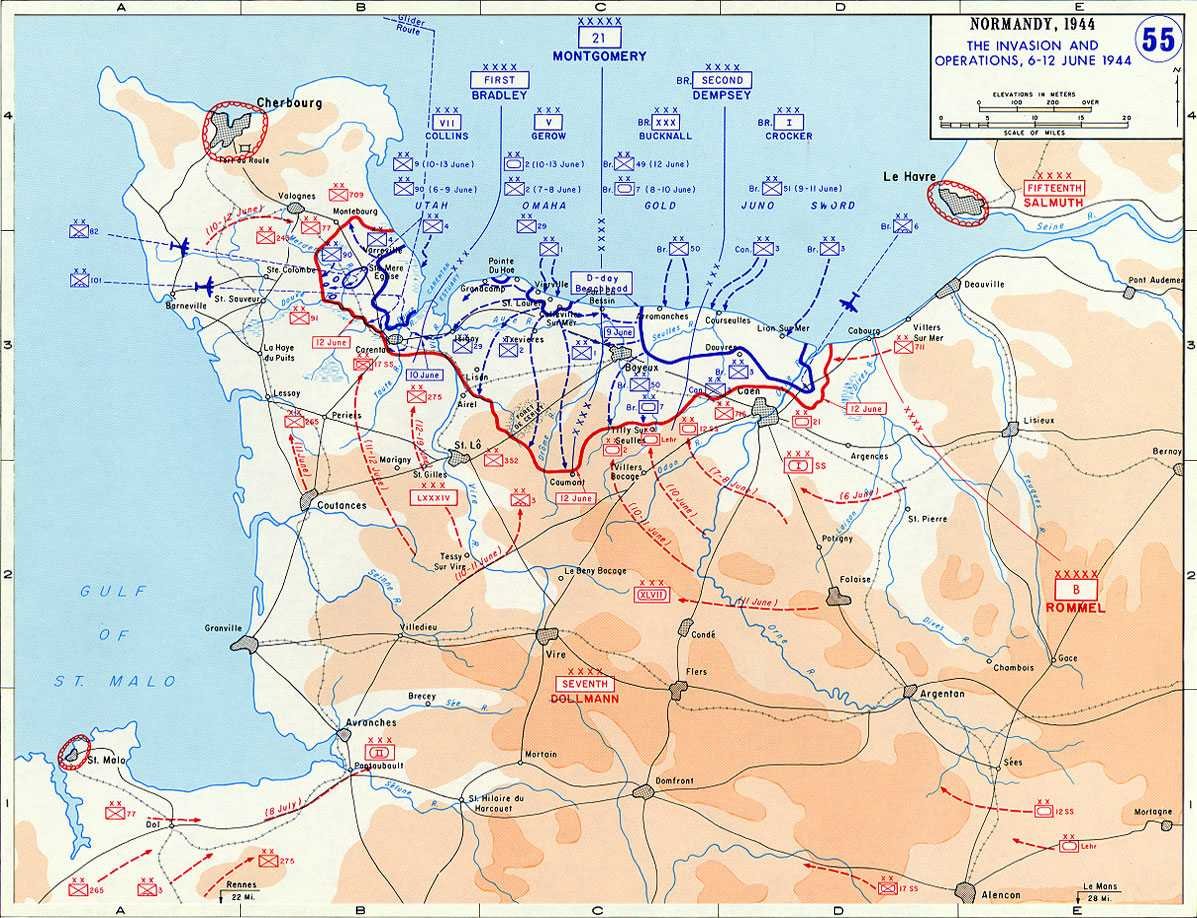
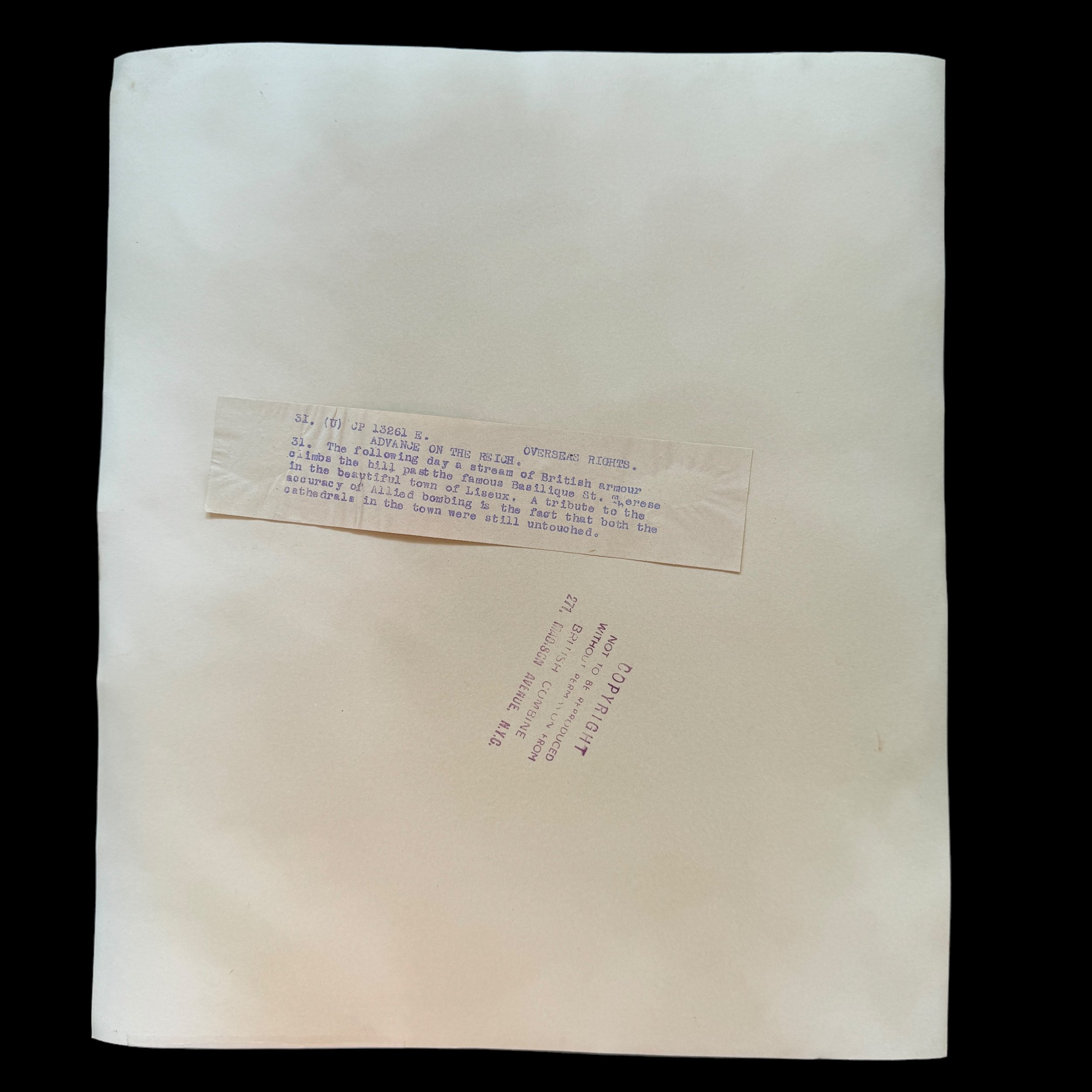





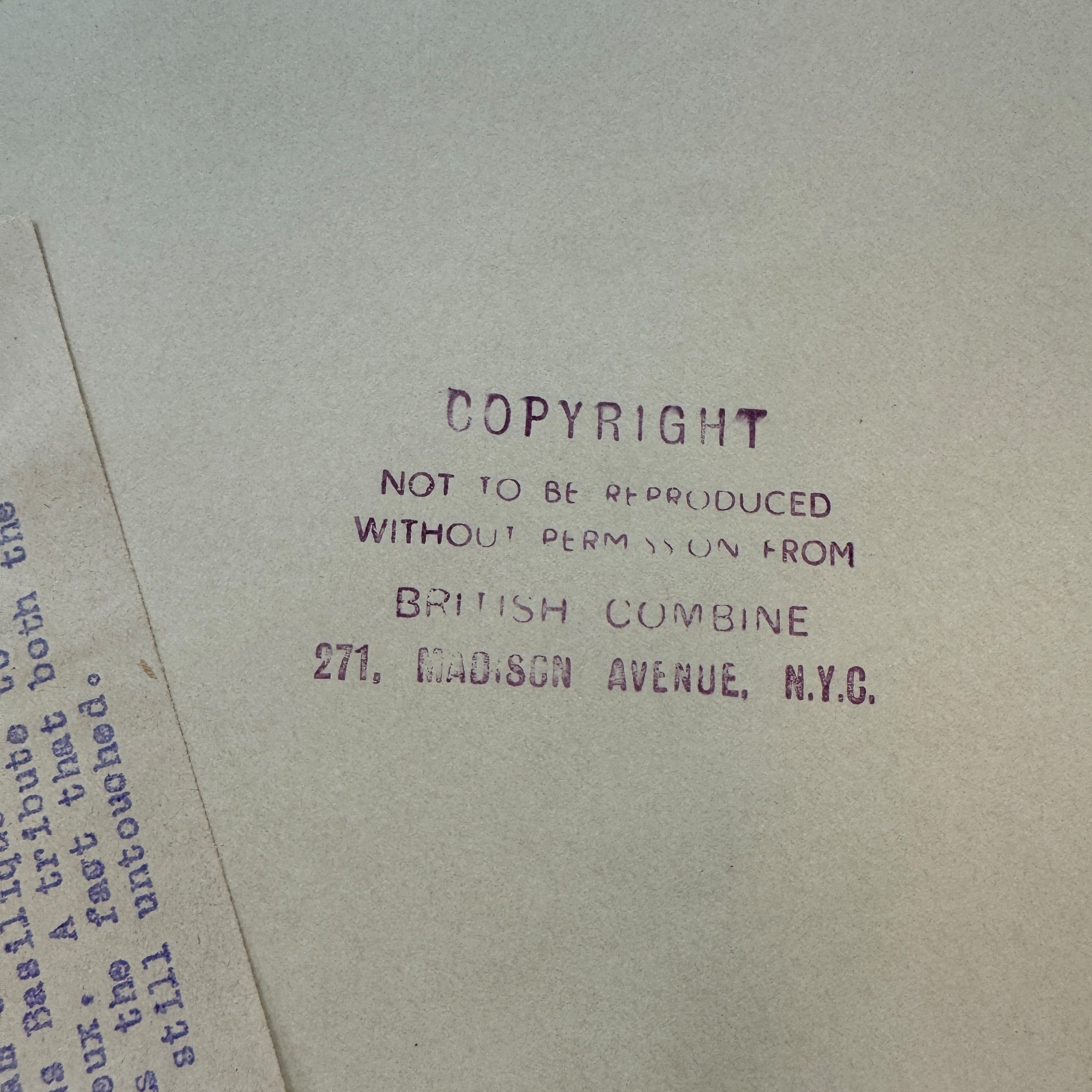





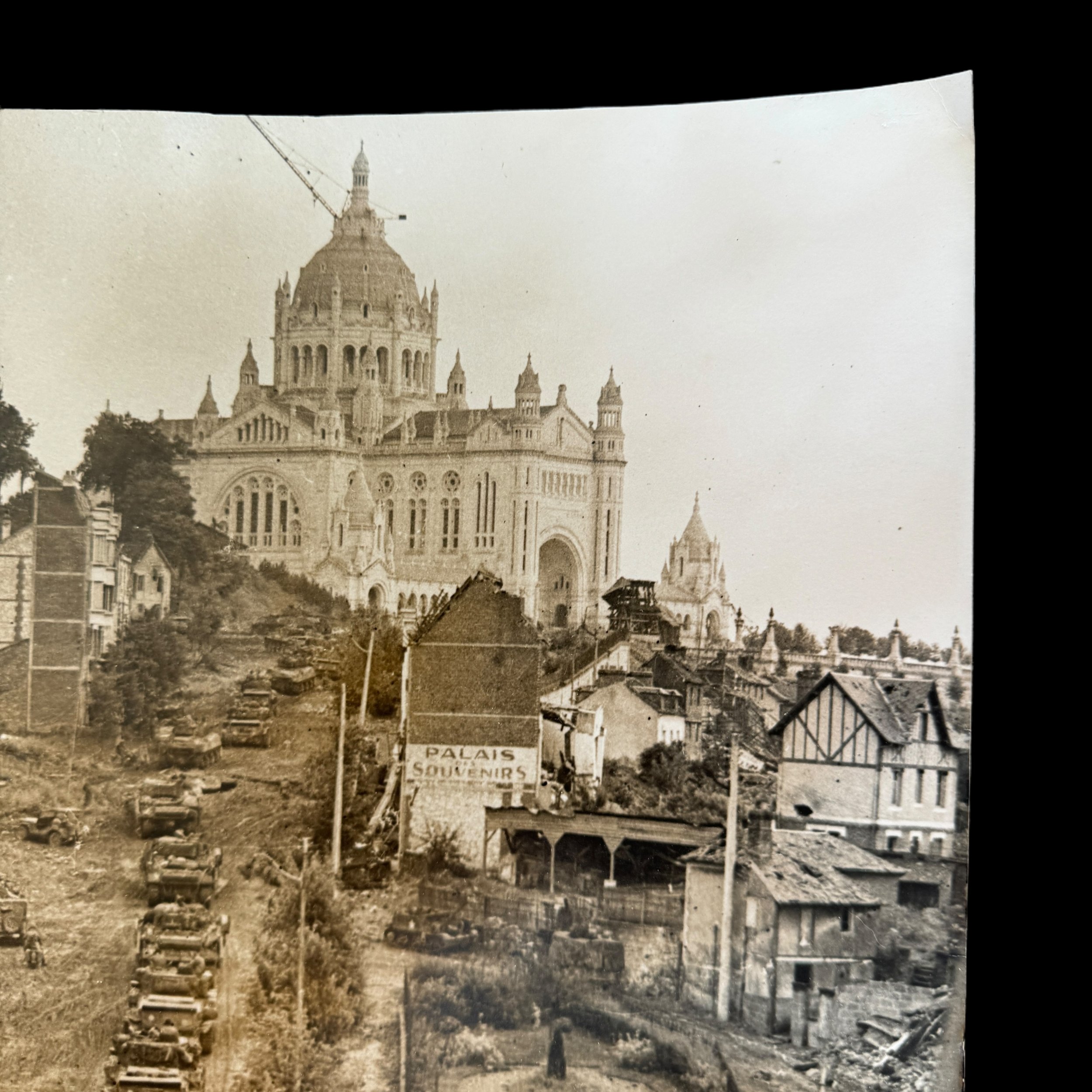
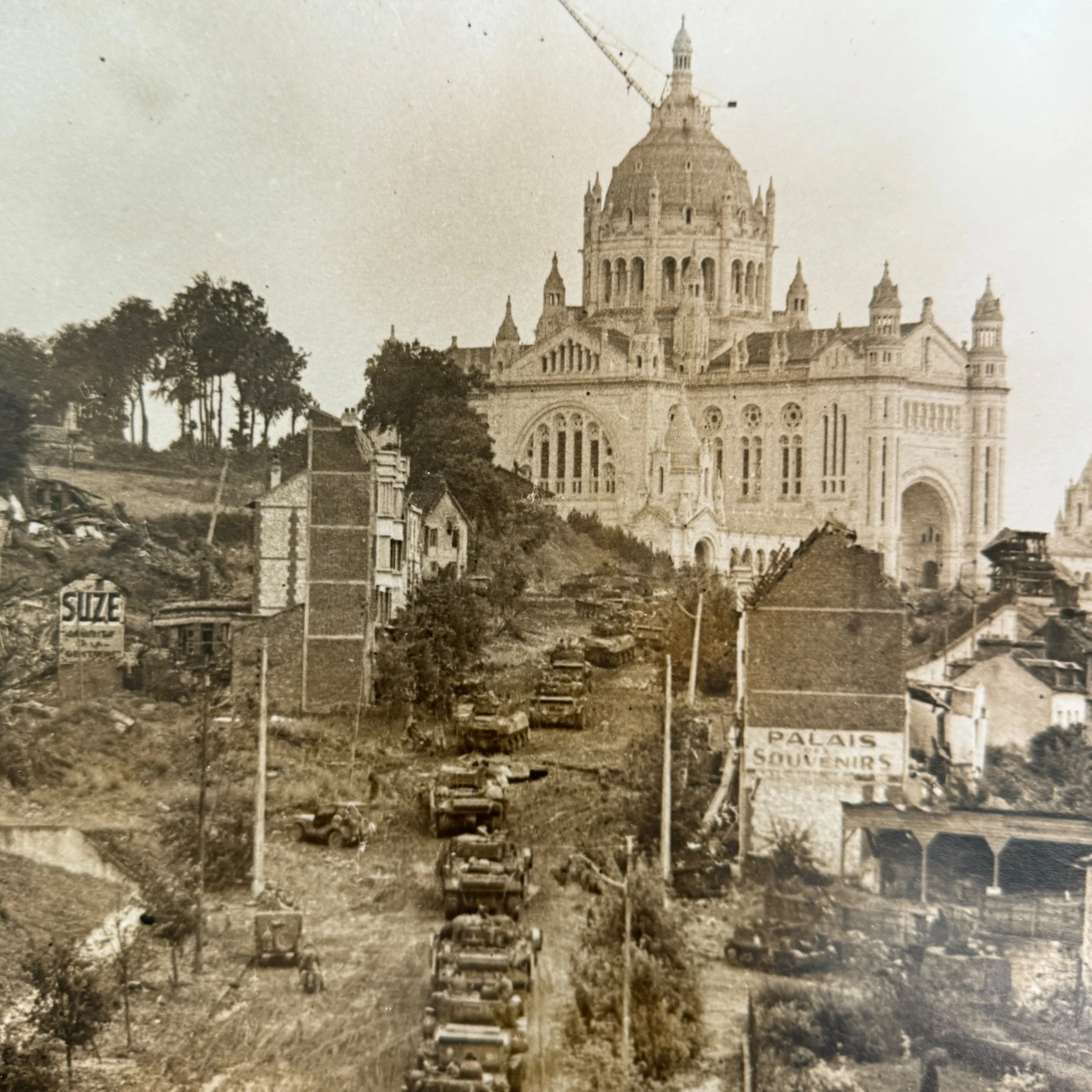




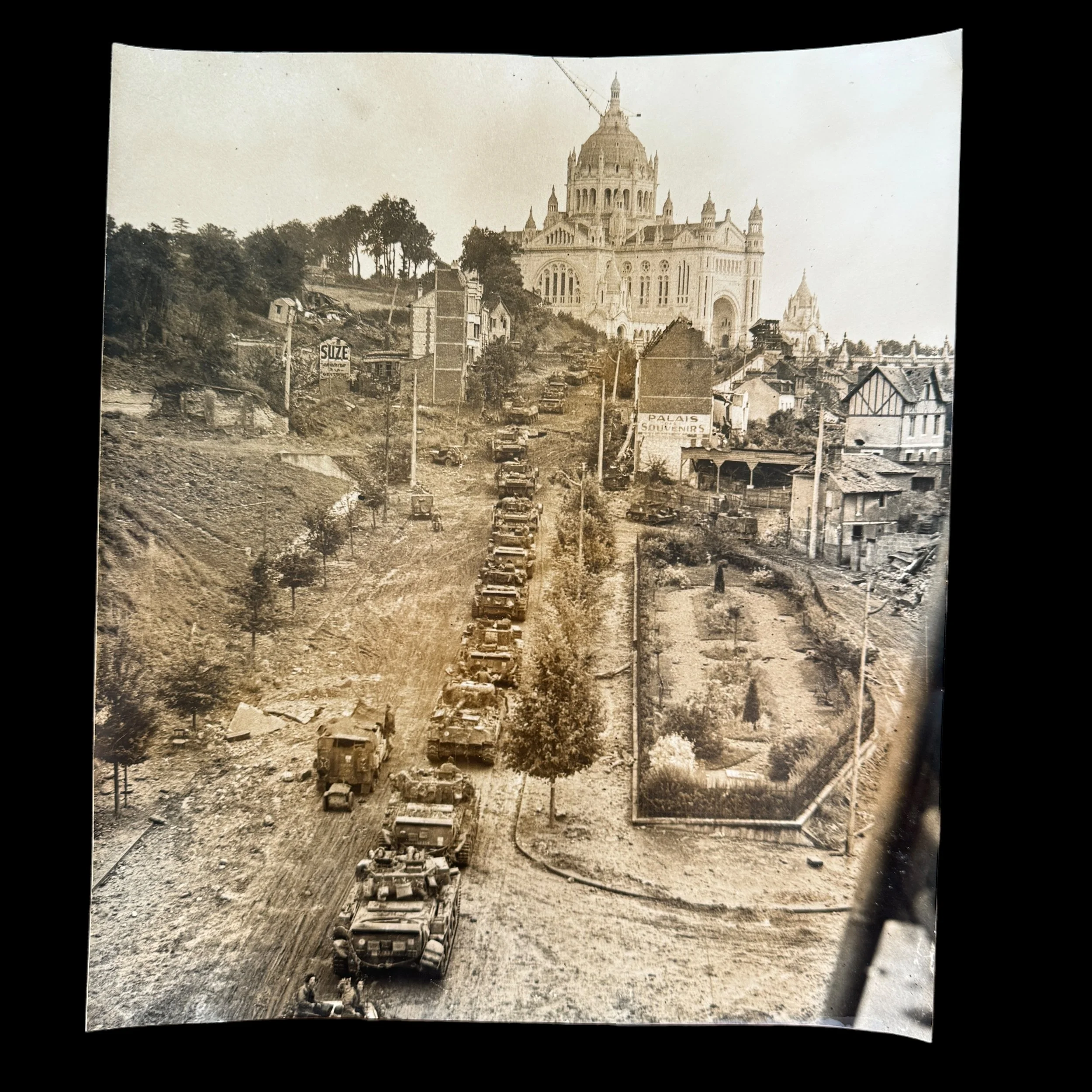

VERY RARE! WWII 1944 Type 1 Invasion of Normandy "1st Royal Tank Regiment - Liberation of Lisieux" British Ministry of Information Photograph Department Press Photograph (OVERSIZED PRINT)
Comes with a hand-signed C.O.A.
Size: 12 x 15 inches
This incredibly rare, museum-grade World War II D-Day Invasion of Normandy artifact is an original 1944-dated “Type 1” Invasion of Normandy press photograph, sourced directly from the British Ministry of Information - Photograph Department. Type 1 photographs are exceptionally scarce as they represent the first high-gloss prints made from original combat negative camera images. These prints feature original marker stamps on the backside, indicating photography information.
What makes this WWII Type 1 Invasion of Normandy photograph even more exceptional is that it is an extremely rare, limited oversized print produced by the British Ministry of Information - Photograph Department. This particular photograph captures a historic moment, showing a column of British Army Cromwell Mk V and M4 Sherman Firefly tanks from the 1st Royal Tank Regiment (1 RTR), 22nd Armoured Brigade of the 7th Armoured Division. The tanks are seen entering Lisieux on August 25, 1944, as they advance through the shell-damaged city towards the Basilica of St. Thérèse in the Normandy region of northwestern France.
The back of this Type 1 photograph still retains the original hand-typed press caption, along with the authentic British Ministry of Information - Photograph Department press stamp. This is a once-in-a-lifetime opportunity to own an original oversized Type 1 combat photograph from the Allied Invasion of Normandy, a true piece of history.
D-Day to Liberation at Lisieux:
At the beginning of June, 1944, the French city of Lisieux, in the heart of the Normandy countryside. had been living under the Nazi Occupation for almost four years. During this time Lisieux and its population had been spared much of the devastation other French towns and cities had experienced. But Lisieux was a vital center of communication with Paris, and, when the Alllies launched their campaign to drive the Germans from France, they pounded Lisieux mercilessly with bombs. It would not be long until the people of Lisieux would see the German occupiers gone forever, but not before much suffering, death, and destruction came upon Lisieux.
D-Day, Tuesday, 6 June 1944 (in the evening)
The Allies bomb Lisieux at 8:30 p.m., aiming at the railroad yards. The raid lasted 30 seconds. The Carmelites were at evening prayer, and they continued their normal life as well as they could.
D + 1, Wednesday, 7 June 1944
A second, much bigger raid came at 2:00 a.m. during the night of June 6-7. Thousands of bombs destroyed many of the buildings in Lisieux. The Benedictine Abbey of Notre Dame due Pre, where Therese had been a student for five years and where she made her First Communion, had a direct hit. The souvenirs of Therese’s schooldays and of her First Communion disappeared. Sixty-three or more religious sisters in Lisieux died in the bombing. The number of deaths reported varied only slightly: contemporaneous accounts said that 21 Benedictines of the Abbey of Notre Dame du Pre, where Therese studied for five years; 20 Sisters of Providence, a nursing order; 10 Little Sisters of the Poor, who maintained a home for elderly men; 10 Sisters of Charity of the Refuge (a home for girls in trouble); and four Sisters of Notre Dame were killed.
Most buildings near the Carmel were destroyed. During the 2:00 a.m. raid, “while everything seemed crumbling and burning around them,” the Carmelite nuns gathered in little groups in the cells and prayed. Fire destroys the chaplain’s house at Carmel and the bookstore, Office Central, threatening the Carmel and the chapel.
At 2:00 p.m. a third aerial bombardment destroyed the esplanade of the Basilica and all the shops near the Basilica. Incendiary bombs fell in the courtyard of the Carmel, which “disappeared in a flash of flame and smoke."
The Carmelite nuns decide to remain in their cloister no matter what. But in the evening, the superior of the Mission de France urges Mother Agnes (the prioress, St. Therese’s sister Pauline) to lead the community to the Basilica, where the Carmel’s chaplains had already taken refuge. Mother Agnes at first feels that the nuns cannot leave the Carmel, but the whole city around the Carmel is burning, and the superior urges her not to stay there alone with the nuns, whose lives were in extreme danger; he says “You have only a few moments to decide.” Mother Agnes says “If it is our duty, we will do it.” The nuns took the Blessed Sacrament from their tabernacle and took it with them to the Basilica. Passing through the door, Mother Agnes blesses her Carmel with the sign of the Cross, and then leaves it for the first time since she had entered it 62 years before (October 2, 1882).
The nuns make their way through the devastation of Lisieux and up the hill to the Basilica of St. Therese. With the few other townspeople who had not evacuated, they shelter in the crypt. They take their place at the front of the crypt, on the right, before the statue of Our Lady of the Smile. They are surrounded by refugees and even by the wounded, whom the brave seminarians of the Mission of France had just dug out of the rubble. The number of refugees is about 80-100, of whom at least 40 were priests and nuns. At certain times in the summer, when refugees came form the countryside, there are more.
Later in the night, the roof of the house of the extern sisters at the Carmel is burned. There is a risk that the chapel containing the reliquary of St Thérèse might be destroyed by the fire. Then the direction of the wind suddenly changes. The chapel is spared. Some people attribute the saving of the chapel to the intercession of St Thérèse.
D + 2, Thursday, 8 June 1944
At daybreak, the fires of the night before are still burning. Most of the town has been evacuated, and few people are left to fight the fires. Priests and seminarians from the 'Mission de France' manage to extinguish the fires that threatened the Carmel. They rescue both the documents in the Carmel’s archive and the reliquary of St Thérèse, and transport them to the Basilica.
Many civilians from Lisieux and its surroundings seek shelter in the Basilica.
The weekend of Saturday 10 June and Sunday 11 June 1944
During the nights of June 10 and June 11, the Allies bomb Lisieux again. The Carmelite monastery and garden are slightly damaged. Three or four Masses are offered in the Basilica every morning all summer, with rosary and Benediction in the evening. In their corner of the crypt, the Carmelites continue to recite the Divine Office.
D + 7, Tuesday, 13 June 1944
A message reaches Mother Agnes from Emmanuel Cardinal Suhard, archbishop of Paris, stating that on May 3, 1944, Pope Pius XII had declared St. Therese secondary patron of France. (St. Joan of Arc is the other secondary patron. The principal patron of France is the Blessed Virgin). To their evening prayer the nuns add the invocation (in Latin): “St. Therese, patron of France, pray for us.”
June and July 1944
The Allies continue to bomb Lisieux and its environs. More civilians seek shelter in the Basilica.
Tuesday, 11 July 1944
By July 11, about three-quarters of the buildings in Lisieux had been destroyed. The priests and nuns in the crypt of the Basilica organize a novena to ask for the intercession of St Thérèse.
Wednesday, 12 July 1944
The first day of the novena to St Thérèse.
Sunday, July 16, 1944
In the crypt, Mother Agnes receives the vows of a young Carmelite nun.
On various days when the military situation permitted it, Mother Agnes visits the Carmel several times to inspect it. She and Sister Genevieve also visit the town cemetery to pray before the tombs of their parents, other members of the family, and other Carmelites. They pray near the spot where Therese’s body had been buried before its return to Carmel in 1923.
Thursday, 20 July 1944
The Basilica is crowded with refugees, including those from nearby villages. Many had already seen their homes and churches destroyed. The clergy make a vow that, if they are delivered, each year they will bring the relics of St. Therese in procession from St. Pierre’s Cathedral to the Basilica. Since the end of the war, this procession has taken place every year on the feast of St. Therese.
Sunday, 6 August 1944
A “perpetual rosary” begins in the crypt of the Basilica. It continues until August 27. At every moment at least three persons were praying this rosary,.
Monday, 7 August - Tuesday, 15 August 1944
In early August 1944 the 'Secours National' (National Relief) offers to transport the Carmelite nuns by truck to Paris. There was talk of a forced evacuation of Lisieux. Reluctant to leave the townspeople, the Carmelites organize a novena of adoration to help them decide. Mother Agnes invites them to pray fervently for light. She gives permission to any Sisters who might want to leave, but they all decide to stay and wait for the outcome of the battle for Lisieux. To prepare for the Feast of the Assumption on August 15, a second general novena is organized in the crypt to pray for the deliverance of Lisieux, the end of the war, and the coming of peace.
Wednesday, 16 August 1944
In Rome, the Pope requests that the religious buildings of Lisieux be respected. The German 'Kommandatur' asks the civil authorities for precise details about the buildings. For some unknown reason, the 'Kommandatur' suddenly leaves, never to return!
Saturday, 19th August 1944
The battle for Lisieux begins in earnest. Artillery fire is aimed at Lisieux. One artillery shell hits the wall of the Carmelite cloister. The doors and windows of the monastery are blown in, and the roof is blown off the wash house.
Monday, 21 August 1944 - Wednesday, 23 August 1944
The battle for Lisieux.
On the night of August 21-22, about 200 German soldiers arrive at the Basilica asking for a place of peace for a few hours so they can sleep. The crypt is crowded with civilian refugees, and the Germans are directed to the upper part of the Basilica.
Tuesday, 22 August 1944 (evening)
The first Allied tanks arrive. They meet strong and determined resistance from German machine guns positioned in the town square. The two sides exchange fire. Some German artillery shells fall in the yard which gives access to the crypt. The religious community and the civilans fear that the Basilica may be destroyed in the fighting. Nevertheless, they continue to pray for deliverance and for the intercession of St Thérèse. One of the Carmelites, Sister Anne of Jesus, writes, on September 8, 1944, this description: “The final battle lasted for 48 hours, and we were between the two fires. I cannot tell you what an uproar it was. It was sinister. Finally on August 25 the last Germans left, and we were able to breathe a little easier . . . .”
Wednesday, 23 August 1944 (evening)
One way or another, the end is in sight with the arrival of British troops. They ask to set up an observation post from the lantern inside the dome of the cathedral and also to install a machine gun. However, this position is abandoned within a few hours as the Germans have departed.
After 48 hours of fierce fighting Lisieux had finally been delivered! Liberation at last and the Basilica has remained largely unharmed.
According to the Basilica archives, the saving of the Basilica from further damage is attributed to Major George Warren of the 1/6 Battalion, Queen's Royal Regiment:
"The Basilica, it was to be knocked down! We were given the order to destroy it because we were told it was protecting Germans. It was already aimed at when we were guaranteed that there were no soldiers. Not wanting to foolishly destroy such a monument we asked on numerous occasions to check if there were no troops hiding here. There was a counter-order but you were very lucky!”
Sunday, 27th August 1944
At the Basilica there is a religious ceremony of thanksgiving. Afterwards, Mother Agnes and the Carmelite nuns, carrying the coral trunk with the relics of St. Therese, return in procession across the ruins of the liberated city to their monastery. They are accmpanied by a crowd of the lay persons with whom they had lived for eighty days and eighty nights. The relics of St. Therese are restored to the chapel.
All the Carmelites of Lisieux survive the battle. Their monastery is slightly damaged, but not destroyed. Les Buissonnets, St. Therese’s family home, remains intact.
The Carmelite nuns return to their usual monastic way of prayer and silence. With the ending of the Battle of Normandy and the liberation of France, many more people from the surrounding countryside come to Lisieux to give thanks for their deliverance.